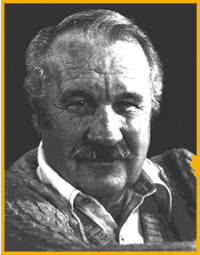by Ray C. Stedman (1914-1992)
[Closely compare both answers below.]
by Ray C. Stedman (1914-1992)
![]()

![]()
Who is God?God consists of three persons: Father, Son and Spirit. We cannot experience him in any other way. But though we usually list him as Father, Son and Spirit, the actual experience of God is different. We first meet the Son, by means of the Spirit, and then the Father. The Father is the source. The Father is unseen, unknown, except as he continually embodies himself (makes himself visible) in the Son. The Son is who we see and hear and know. He is ceaselessly embodying the Father, day by day, hour by hour, moment by moment. He is perpetually revealing the Father, hitherto invisible. The Father is logically first, but not chronologically. For the Son exists as long as the Father exists, and is coexistent with the Father. The Father acts through and in the Son. He makes himself visible only in the Son. It is in the Son that the Father becomes a part of human life, and so is born and lives and dies in human life. The Spirit, in turn, comes from the Son . He does not embody the Son. On the contrary, God, in issuing from the Son into the Spirit becomes invisible again. The Spirit proceeds silently, endlessly, invisibly from the Son. But the Son is not the source of the Spirit which proceeds from him. The Father is the source of both the Son and the Spirit. Back of the Son is the Father out of which the Son comes. The Spirit issues and proceeds from the Father, through the Son. The Son therefore comes out from the invisible Father and perpetually and ever-newly embodies the Father in visible, audible, livable form, and returns again into invisible God in the Spirit. The Spirit acts invisibly. He continually influences us with regard to the Son. He casts light upon the Son. That is his great function. He helps us to live in the Son which we know, and with reference to the Father whom we expect to see. |
What is Time?Time consists of three dimensions: Past, Present and Future. We cannot experience it in any other way. But though we usually list it as Past, Present and Future, the actual flow of Time is the reverse. It comes out of the future, through the present, into the past. The Future is the source. The Future is unseen, unknown, except as it continually embodies itself (makes itself visible) in the Present. The Present is what we see and hear and know. It is ceaselessly embodying the Future, day by day, hour by hour, moment by moment. It is perpetually revealing the Future, hitherto invisible. The Future is logically first, but not chronologically. For the Present exists as long as Time exists, and is coexistent with Time. Time acts through and in the Present. It makes itself visible only in the Present. It is in the Present that the Future becomes a part of human life, and so is born and lives and dies in human life. The Past, in turn, comes from the Present. It does not embody the Present. On the contrary, Time, in issuing from the Present into the Past becomes invisible again. The Past proceeds silently, endlessly, invisibly from the Present. But the Present is not the source of the Past which proceeds from it. The Future is the source of both the Present and the Past. Back of the Present is the Future out of which the Present comes. The Past issues and proceeds from the Future, through the Present. The Present therefore comes out from the invisible Future and perpetually and ever-newly embodies the Future in visible, audible, livable form, and returns again into invisible Time in the Past. The Past acts invisibly. It continually influences us with regard to the Present. It casts light upon the Present. That is its great function. It helps us to live in the Present which we know, and with reference to the Future which we expect to see.
|
With thanks to Walt McCuistion. June 17, 1995.
Also see Who is God?